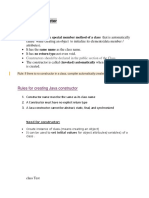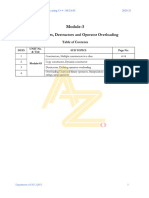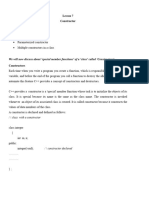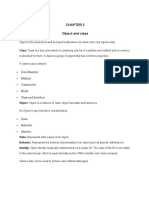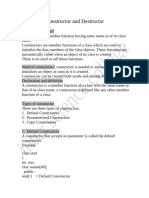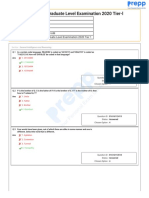Constructors in Java
Constructors in Java
Uploaded by
zemo kumarCopyright:
Available Formats
Constructors in Java
Constructors in Java
Uploaded by
zemo kumarCopyright
Available Formats
Share this document
Did you find this document useful?
Is this content inappropriate?
Copyright:
Available Formats
Constructors in Java
Constructors in Java
Uploaded by
zemo kumarCopyright:
Available Formats
Constructors in Java
A constructor is a member function of a class with the same name as that of its class name. it is
defined like other member function of a class. It is used to initialize the data member.
Characteristics of constructor:
1. It has same name as the class-name.
2. It cannot have a return type, not even void is used.
3. It gets called automatically whenever an object is created.
use of constructor :
Allocate memory space for an object.
Initialize data members/ instance variable of the class
Types of Constructor :
1. Non Parameterized Constructor
2. Parameterized Constructor
Non Parameterized Constructors : A constructor that accepts no parameters are called non
parameterized constructors, non parameterized constructors that initialize the instance
variables to zero, null and empty values are called Default Constructors.
1. class Constr
{
int n;
Constr( )
{
n = 0;
} // invokes the constructor
public static void main( )
{
Constr obj = new Constr( );
System.out.println(obj.n);
}
}
Parameterized Constructor : A parameterized constructor accepts parameters or
values in its argument list which initialize the various instance data members of the class.
class Constr
{
int n;
Constr(int val)
{
n = val;
} // invokes the constructor
public static void main( )
{ int v = 25;
Constr obj = new Constr(v);
}
}
constructor overloading : When two or more constructor with different function parameter is
defined in a class then it is called constructor overloading.
class Overload
{
int a,b;
Overload()
{
a=10;
b=20;
}
Overload(int x, int y)
{
a=x;
b=y;
}
public static void main()
{
Overload obj1 =new Overload(); //Calls the first constructor version.
Overload obj2 = new Overload(5,8); //Calls the 2rd constructor version.
}
}
Difference between constructor and method :
Constructor Method
Class name and constructor name should Method can have any name following
be same identifier naming rule
It is used only for initializing data member Can do any type of calculation or
printing.
It is not return type It has return type
It is called automatically It has to be called
You might also like
- Chromic Acid Oxidation of AlcoholsDocument3 pagesChromic Acid Oxidation of AlcoholsDiana Catalina CruzNo ratings yet
- Constructors 1Document12 pagesConstructors 1sheelaNo ratings yet
- Class7 (Constructor in Java)Document9 pagesClass7 (Constructor in Java)Doton DuttaNo ratings yet
- Constructors in JavaDocument18 pagesConstructors in JavaAmol AdhangaleNo ratings yet
- Constructors in JavaDocument19 pagesConstructors in JavaAmol AdhangaleNo ratings yet
- Constructors in JavaDocument19 pagesConstructors in JavaAmol AdhangaleNo ratings yet
- Java - 5.1 Constructors PDFDocument24 pagesJava - 5.1 Constructors PDFRekh aNo ratings yet
- Soda Chapter 7Document20 pagesSoda Chapter 7dinesh9866119219No ratings yet
- Constructor Final 10-10-2024Document48 pagesConstructor Final 10-10-2024Putta SwamyNo ratings yet
- 10 Cons & DescDocument22 pages10 Cons & DescAnkesh KunwarNo ratings yet
- ITE 2132 - Object Oriented Programming ConceptsDocument14 pagesITE 2132 - Object Oriented Programming Conceptssilvadevika07No ratings yet
- Constructors What Is A Constructor?Document5 pagesConstructors What Is A Constructor?Bharathi LakshmiNo ratings yet
- Constructors in JavaDocument16 pagesConstructors in JavanandinipoddarqmsNo ratings yet
- 15-09-2022 Day 9 (Constructor, Types of Constructor, Constructor Chaining)Document4 pages15-09-2022 Day 9 (Constructor, Types of Constructor, Constructor Chaining)Vyshak AppuNo ratings yet
- CH 4 Constructors What Is A Constructor?Document2 pagesCH 4 Constructors What Is A Constructor?shubhaliNo ratings yet
- Class&constructorDocument9 pagesClass&constructorragulr239No ratings yet
- 7.Constructors-2024-25_3Document6 pages7.Constructors-2024-25_3aerosmp09No ratings yet
- Oop Mod3@Azdocuments - inDocument60 pagesOop Mod3@Azdocuments - inShankar MNo ratings yet
- ConstructorDocument7 pagesConstructorRizvin RifatNo ratings yet
- Lecture 07Document11 pagesLecture 07Joash MacentonNo ratings yet
- ConstructorDocument12 pagesConstructorclashbros563No ratings yet
- Notes Unit 3Document18 pagesNotes Unit 3amankureshi060906No ratings yet
- Constructor Questions AnswerDocument7 pagesConstructor Questions AnswerAditya MalgaveNo ratings yet
- Week 3-LectureA OOPsDocument34 pagesWeek 3-LectureA OOPsFarhan GhafoorNo ratings yet
- Unit 2Document13 pagesUnit 2SUREDDY TANUJA MSCS2018No ratings yet
- Chapter 4 Object Constructions and DestructionsDocument5 pagesChapter 4 Object Constructions and DestructionsUtsav PathakNo ratings yet
- OOps Chapter 3.Document16 pagesOOps Chapter 3.Magarsaa Qana'iiNo ratings yet
- UNIT 9 ConstructorDocument13 pagesUNIT 9 Constructor22002171310048No ratings yet
- Chapter 9-Constructors & Destructors (61-71)Document12 pagesChapter 9-Constructors & Destructors (61-71)Khushi Y.SNo ratings yet
- OOP Chapter 3Document14 pagesOOP Chapter 3ashagerie asfawNo ratings yet
- Online Class 4-Constructors and DestructorsDocument25 pagesOnline Class 4-Constructors and DestructorsSoutik DeyNo ratings yet
- Class:10 Subject: Computer Applications: LS 10. Constructors Important PointsDocument7 pagesClass:10 Subject: Computer Applications: LS 10. Constructors Important Pointskoushik reddyNo ratings yet
- Java Unit 2Document20 pagesJava Unit 2pandu mandalaNo ratings yet
- CONSTRUTOR Theory Notes For Class 10Document6 pagesCONSTRUTOR Theory Notes For Class 10trishagupta782No ratings yet
- 1.constructors in JavaDocument21 pages1.constructors in JavaAkashdeep BhattacharjeeNo ratings yet
- C# Unit III NotesDocument20 pagesC# Unit III Notesvishalj1006No ratings yet
- Session 13Document23 pagesSession 13yadvji568No ratings yet
- Constructor in JavaDocument3 pagesConstructor in JavaSanket BodadeNo ratings yet
- C++ ConstructorDocument13 pagesC++ Constructorketankumar2614No ratings yet
- Part 3Document13 pagesPart 3rohittestuser255No ratings yet
- Types of Constructor OOPS 6Document7 pagesTypes of Constructor OOPS 6raiarya3406No ratings yet
- 15cs45 Ooc Notes Module 3Document35 pages15cs45 Ooc Notes Module 3aNo ratings yet
- Unit 2 Java Programmingg Question AnswerDocument25 pagesUnit 2 Java Programmingg Question Answerpranavchavan3103No ratings yet
- BCS-031 - C++ ProgrammingDocument21 pagesBCS-031 - C++ Programmingvipinfrancis1988No ratings yet
- chapter 5Document7 pageschapter 5pinkudeb2006No ratings yet
- Object OrientedDocument16 pagesObject Orientedfarhan.mukhtiarNo ratings yet
- CONSTRUCTORDocument9 pagesCONSTRUCTORAakriti MehtaNo ratings yet
- Unit 4: Constructors and DestructorsDocument62 pagesUnit 4: Constructors and DestructorsMD AKHLAQUR RAHMANNo ratings yet
- Constructor & DestructorDocument9 pagesConstructor & DestructorabxrntNo ratings yet
- Module 3 CPP NewDocument21 pagesModule 3 CPP NewA 18No ratings yet
- Constructors in Java PDFDocument7 pagesConstructors in Java PDFSheshgiri SheshuNo ratings yet
- DBMS Chapter 5Document20 pagesDBMS Chapter 5reddynanda426No ratings yet
- ConstructorsDocument7 pagesConstructorsM UmarNo ratings yet
- Unit II - Constructor&DestructorDocument6 pagesUnit II - Constructor&DestructorSaravana Kumar RNo ratings yet
- Polymorphism & Inheritance in C#Document50 pagesPolymorphism & Inheritance in C#eshamuNo ratings yet
- Constructors and Blocks in JavaDocument4 pagesConstructors and Blocks in Javashreyahv48No ratings yet
- Unit 2Document26 pagesUnit 2shamithashibuNo ratings yet
- ConstructorDocument31 pagesConstructorarpanabharaniNo ratings yet
- Java ConstructorsDocument17 pagesJava ConstructorsKushagra KrishnaNo ratings yet
- Constructor DestructorDocument19 pagesConstructor Destructorabhijeetpundir27No ratings yet
- Java Programming Tutorial With Screen Shots & Many Code ExampleFrom EverandJava Programming Tutorial With Screen Shots & Many Code ExampleNo ratings yet
- Boat NomenclatureDocument5 pagesBoat NomenclatureAshok KamathNo ratings yet
- Asx 24 Interest Rate Price and Valuation GuideDocument12 pagesAsx 24 Interest Rate Price and Valuation GuideKai ChenNo ratings yet
- Rampa Mecanica Blue Giant Mod. U-SeriesDocument20 pagesRampa Mecanica Blue Giant Mod. U-SeriesAzul IndigoNo ratings yet
- Minerals For Climate Action:: The Mineral Intensity of The Clean Energy TransitionDocument112 pagesMinerals For Climate Action:: The Mineral Intensity of The Clean Energy TransitionJuan AlbertoNo ratings yet
- 4037 s19 QP 11Document16 pages4037 s19 QP 11Shamvil RazaNo ratings yet
- Obstructed LaborDocument41 pagesObstructed LaborHenok Y KebedeNo ratings yet
- Crochets My Tiny HeartDocument4 pagesCrochets My Tiny HeartLauraNo ratings yet
- Cross Co-Teaching For Semi - Supervised Medical Image SegmentationDocument15 pagesCross Co-Teaching For Semi - Supervised Medical Image Segmentationaman soniNo ratings yet
- Answers:: 2 Out of 2 PointsDocument14 pagesAnswers:: 2 Out of 2 PointsCy RocamoraNo ratings yet
- Bird Diverter PresentationDocument12 pagesBird Diverter PresentationFede TapiaNo ratings yet
- Hardware Implementation of Real-Time Multiple Frame Super-ResolutionDocument6 pagesHardware Implementation of Real-Time Multiple Frame Super-Resolutionmouhamed al amin BenattiaNo ratings yet
- Precalculus: Senior High School Grade 11Document28 pagesPrecalculus: Senior High School Grade 11Gerlie Jay-ann RamosNo ratings yet
- BY Diksha Arora Tushar Sharma Khwaish Thakur BATCH: 27Document13 pagesBY Diksha Arora Tushar Sharma Khwaish Thakur BATCH: 27Pankhuri AryaNo ratings yet
- 4.1 Parametric EquationsDocument3 pages4.1 Parametric EquationsJericho CunananNo ratings yet
- 05 Membrane Transport VDocument27 pages05 Membrane Transport Vmaksud alaNo ratings yet
- Chapter 1Document11 pagesChapter 1pkuranjeNo ratings yet
- Components of Health Related Fitness LONGDocument6 pagesComponents of Health Related Fitness LONGClark NuevoNo ratings yet
- Frank Sinatra Lyrics - Cheek To Cheek PDFDocument1 pageFrank Sinatra Lyrics - Cheek To Cheek PDFalfonsoNo ratings yet
- Chief Seattles Speech STD 9 and 10Document4 pagesChief Seattles Speech STD 9 and 10SukanshiNo ratings yet
- SDS - Sodium-Hypochlorite-Solution-10-15Document7 pagesSDS - Sodium-Hypochlorite-Solution-10-15BigbearBigbearNo ratings yet
- Wa0004.Document4 pagesWa0004.Paras GuptaNo ratings yet
- What To Know About Eyebrow TransplantsDocument5 pagesWhat To Know About Eyebrow TransplantsOliver Carrasco VilladomaNo ratings yet
- Overview of MicroemulsionDocument13 pagesOverview of MicroemulsionEditor IJTSRDNo ratings yet
- Test PaperDocument3 pagesTest PaperPîrja Ana MariaNo ratings yet
- ScabiesDocument14 pagesScabiessyemiNo ratings yet
- Naskah Drama Lutung KasarungDocument7 pagesNaskah Drama Lutung KasarungAkbar AbbasyNo ratings yet
- TKT-CM-01-OM-1060-I-R1-O&M Manual - Control & Monitoring System PDFDocument144 pagesTKT-CM-01-OM-1060-I-R1-O&M Manual - Control & Monitoring System PDFThái Đức NhơnNo ratings yet
- SAN and Storage Foundations Test For Channel PartnersDocument12 pagesSAN and Storage Foundations Test For Channel PartnersThong pham duyNo ratings yet
- SSC CGL Tier-1 Shift 1 - 17 08 2021Document31 pagesSSC CGL Tier-1 Shift 1 - 17 08 2021param.vennelaNo ratings yet

